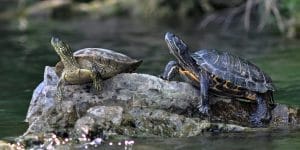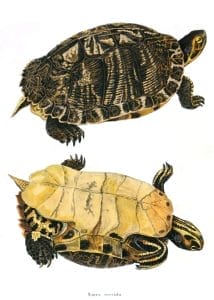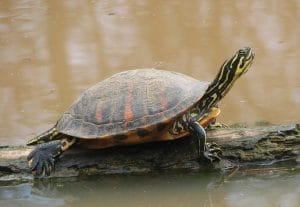Pseudemys rubriventris (Northern Red-bellied Cooter)
Home > Turtle Database > Pseudemys rubriventris (Northern Red-bellied Cooter)

The Northern Red-bellied Cooter is a freshwater turtle known for its striking red plastron and smooth, dark carapace. It’s one of the largest native pond turtles in the northeastern United States and is especially notable for its endangered status in some regions.
Native To These Regions
Delaware (USA), Maryland (USA), Massachusetts (USA), New Jersey (USA), North Carolina (USA), Pennsylvania (USA), Virginia (USA)Native Turtle Species Map – Find Turtles by Region
Scientific Classification
Kingdom: Animalia
Phylum: Chordata
Class: Reptilia
Order: Testudines
Family: Emydidae
Genus: Pseudemys
Species: Pseudemys rubriventris
Common Names
Northern Red-bellied Cooter
Red-bellied Turtle
This Hilarious Turtle Book Might Know Your Pet Better Than You Do
Let’s be real—most turtle care guides feel like reading a textbook written by a sleep-deprived zookeeper.
This one’s not that.
Told from the snarky point of view of a grumpy, judgmental turtle, 21 Turtle Truths You’ll Never Read in a Care Guide is packed with sarcasm, sass, and surprisingly useful insights.
And hey—you don’t have to commit to the whole thing just yet.
Grab 2 free truths from the ebook and get a taste of what your turtle really thinks about your setup, your food choices, and that weird plastic palm tree.
It’s funny, it’s honest, and if you’ve ever owned a turtle who glares at you like you’re the problem—you’ll feel seen.
Identification
Description
This turtle has a broad, smooth carapace that ranges from dark green to brown, often with faint markings. The plastron is bright red or orange with dark blotches. It has yellow stripes on its head and limbs. Adults typically reach 10 to 12 inches in shell length.
Sexual Dimorphism
Males are smaller with longer claws and a longer, thicker tail. Females grow larger and have shorter claws.
Check more turtles from the Pseudemys genus
Native Origin and Distribution
Geographical Range
Native to the eastern United States, especially from New Jersey to North Carolina. A unique, isolated population exists in Massachusetts, where it’s state-listed as endangered.
Preferred Habitat
They thrive in slow-moving freshwater bodies like ponds, lakes, rivers, and marshes with abundant aquatic vegetation. They prefer areas with basking spots and muddy bottoms.
Behavior
Feeding Habits
Juveniles are more carnivorous, eating insects, snails, and fish. Adults shift to a mostly herbivorous diet, feeding on aquatic plants and algae.
Predators
Eggs and hatchlings are often eaten by raccoons, foxes, skunks, and birds. Adults have fewer natural predators due to their size and hard shell.
Reproduction
Breeding Season
Mating occurs in spring, usually between April and June.
Reproductive Method
Females lay 10 to 20 eggs in sandy or soft soil near water. Incubation lasts about 70 to 80 days, and hatchlings emerge in late summer or early fall.
Conservation
Extinction Status
Listed as Near Threatened by IUCN.
Threats
Habitat destruction, road mortality, water pollution, and illegal collection for the pet trade.
Conservation Measures
Protected nesting areas, road-crossing tunnels, habitat restoration, and captive breeding programs are being used to support population recovery.
Economic Importance
Has limited economic value but plays a role in ecosystem health by controlling aquatic vegetation. It’s also occasionally kept in the pet trade, though wild collection is restricted.
Interesting Facts
Some hatchlings remain in the nest through winter and emerge in spring.
It’s one of the few turtles in the U.S. that’s protected at the state level due to its limited and shrinking range.

About Author
Muntaseer Rahman started keeping pet turtles back in 2013. He also owns the largest Turtle & Tortoise Facebook community in Bangladesh. These days he is mostly active on Facebook.














